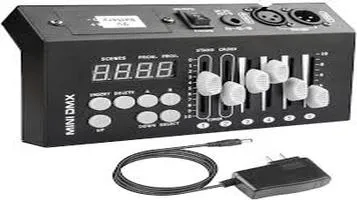DMX Controllers
DMX controllers are essential devices in the field of lighting technology, providing centralized control over a wide array of lighting fixtures and effects. DMX, which stands for Digital Multiplex, is a communication protocol used to control stage lighting and effects. These controllers send digital signals to DMX-compatible fixtures, allowing users to manipulate attributes such as intensity, color, and movement with precision. Widely used in theaters, concerts, and architectural lighting, DMX controllers range from simple desks to sophisticated software-based systems. They enable the creation of complex lighting scenes and dynamic effects, enhancing visual experiences. DMX controllers support a scalable configuration, making them suitable for both small venues and large-scale productions, offering versatility and creative freedom to lighting designers.

In the ever-evolving world of lighting technology, DMX controllers stand as a central pillar for achieving sophisticated and dynamic lighting effects. DMX, which stands for Digital Multiplex, is a standardized protocol used to control stage lighting and effects. It has become the industry standard, providing unparalleled control and flexibility for lighting designers, DJs, event planners, and stage managers. In this review, we will delve into the various aspects of DMX controllers, exploring their features, advantages, limitations, and practical applications.
Overview of DMX Controllers
DMX controllers function as the brain of a lighting setup, sending signals to multiple lighting fixtures to execute pre-programmed or real-time commands. These controllers range from simple, entry-level units to highly advanced, professional-grade systems capable of managing extensive lighting rigs. The choice of a DMX controller often depends on the complexity of the lighting setup, the specific needs of the user, and the scale of the production.
Features and Capabilities
One of the standout features of DMX controllers is their ability to manage a vast array of lighting fixtures simultaneously. A standard DMX universe consists of 512 channels, with each channel controlling an individual parameter of a lighting fixture, such as intensity, color, or movement. Advanced controllers can handle multiple DMX universes, exponentially increasing the number of controllable channels.
Modern DMX controllers often come equipped with a range of features designed to enhance usability and functionality. These may include:
1. Programmable Scenes and Chases: Users can create and store complex lighting scenes and dynamic chases, which can be triggered at the touch of a button. This is particularly useful for live events where precise timing and coordination are crucial.
2. MIDI and Audio Integration: Many controllers offer MIDI compatibility, allowing synchronization with musical instruments and other audio equipment. This integration enables the creation of audio-reactive lighting shows, adding a new dimension to performances.
3. Touchscreen Interfaces: High-end controllers frequently feature intuitive touchscreen interfaces, simplifying the programming process and providing quick access to essential functions.
4. Wireless Control: Some DMX controllers support wireless connectivity, enabling remote operation from smartphones, tablets, or other wireless devices. This feature offers greater flexibility and convenience, particularly in large venues.
5. Fixture Libraries: DMX controllers often come with extensive libraries of pre-configured profiles for various lighting fixtures, streamlining the setup process and ensuring compatibility with a wide range of equipment.
Advantages of DMX Controllers
The primary advantage of DMX controllers is their ability to offer precise and granular control over lighting fixtures. This precision allows lighting designers to craft intricate and visually stunning lighting displays, enhancing the overall ambiance and impact of a performance or event.
Another significant benefit is the scalability of DMX systems. Whether you're managing a small setup with a handful of fixtures or a large-scale production with hundreds of lights, DMX controllers can be scaled to meet the demands of the project. This scalability ensures that users can continue to expand and upgrade their lighting setups without needing to invest in an entirely new control system.
Additionally, the widespread adoption of the DMX protocol means that DMX controllers are compatible with a vast array of lighting fixtures from various manufacturers. This interoperability provides users with the flexibility to mix and match equipment to suit their specific needs and preferences.
Limitations and Considerations
Despite their many advantages, DMX controllers are not without limitations. One potential drawback is the complexity of programming and operating these devices, particularly for beginners. The sheer number of channels and parameters can be overwhelming, and achieving the desired effects often requires a steep learning curve. However, many manufacturers offer comprehensive manuals, tutorials, and customer support to assist users in mastering their controllers.
Another consideration is the physical limitations of DMX cabling. Traditional DMX systems rely on wired connections, which can be cumbersome in large venues or installations where cable runs are impractical. While wireless DMX solutions are available, they can be susceptible to interference and signal dropouts, potentially compromising the reliability of the lighting control.
Practical Applications
DMX controllers find applications in a wide range of settings, from theatrical productions and concerts to architectural lighting and club environments. In theaters, DMX controllers enable precise control over stage lighting, allowing for seamless transitions and dramatic effects that enhance the storytelling experience. In concert settings, they facilitate the synchronization of lighting with live music, creating immersive and engaging performances.
Architectural lighting designers use DMX controllers to highlight and transform buildings, monuments, and public spaces, adding visual interest and enhancing the aesthetic appeal of urban environments. In clubs and nightlife venues, DMX controllers are essential for creating dynamic and responsive lighting displays that energize the crowd and elevate the overall atmosphere.
Conclusion
In conclusion, DMX controllers are indispensable tools for anyone involved in the art and science of lighting design. Their ability to manage complex lighting setups with precision and flexibility makes them a vital component of modern lighting systems. While they may pose a learning curve for beginners, the potential rewards in terms of creative possibilities and control are well worth the investment. Whether you're lighting a small event or a large-scale production, DMX controllers provide the tools necessary to bring your vision to life.






